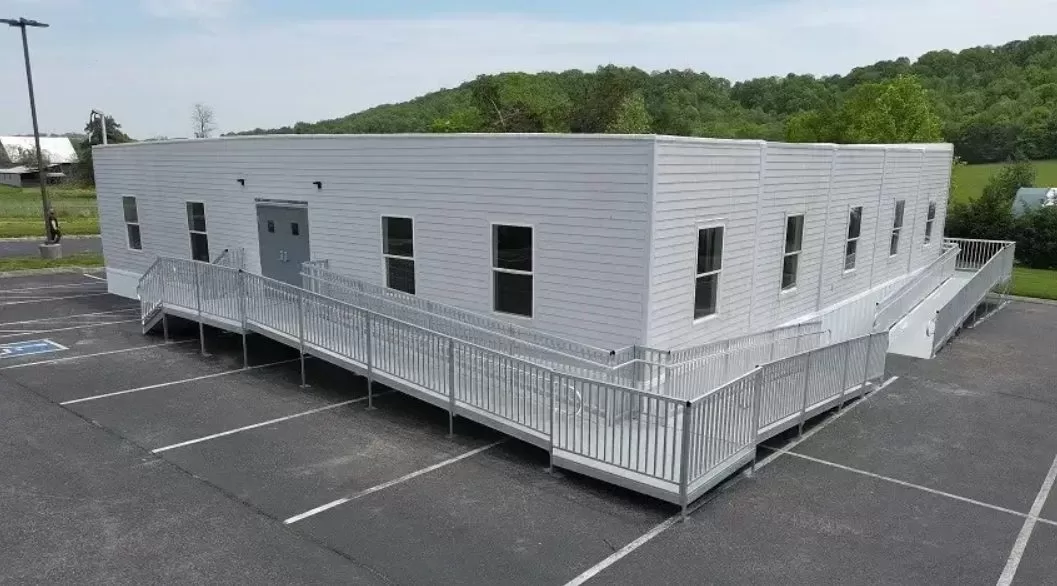
Workplace access ramps are a simple part of daily work life, yet they can pose serious risks if not designed and maintained properly. That’s why the Occupational Safety and Health Administration, or OSHA, has clear guidelines to ensure workplace ramps are safe for employees. Knowing the rules can help prevent accidents before they happen.
OSHA’s access ramp requirements apply primarily to workplaces, from construction sites to warehouses and factories. Their focus is on worker safety and preventing injuries, whether someone is walking up a ramp, moving equipment, or handling heavy loads. These rules do not cover ramps built for customers or the general public; those fall under the ADA or local building codes.
Learn about the difference between OSHA and ADA.
Key OSHA considerations for workplace ramps include:
- Slope: Workplace ramps should generally have a gentle incline, no steeper than a 1:3 ratio, to prevent slips and falls and make it manageable for workers carrying equipment.
- Width and Load: Ramps must be wide enough for the intended traffic and strong enough to safely support workers and any equipment they move.
- Surface Conditions: A slip-resistant surface is essential. Ramps should be free of obstacles, debris, or damage that could cause accidents.
- Guardrails and Edge Protection: If a ramp is elevated, guardrails or curbs help prevent falls and protect both people and equipment.
- Maintenance and Inspection: Safety is ongoing. Regular checks and prompt repairs are critical to keep ramps reliable.

How to Choose the Right Workplace Access Ramp
Choosing the right access ramp for your workplace means balancing compliance with practicality. OSHA gives you the baseline requirements, but the best ramp for your space depends on how and where it will be used.
Start by thinking about your environment – indoors or outdoors, permanent or temporary – and the type of traffic it needs to support. A warehouse workplace ramp that sees daily forklift use has different demands than an employee access ramp at an office.
Material choice also makes a big difference. While steel and wood ramps have their uses, aluminum ramps are a more long-term choice because they combine durability, weather resistance, and low maintenance, while offering modular flexibility to fit changing workplace needs.
No matter the material, look for features that promote safety and efficiency: non-slip surfaces, guardrails where needed, and modular designs that make adjustments simple as your operations evolve.
Access Ramps for Safety, Confidence, and Peace of Mind
Following OSHA’s guidelines doesn’t just protect workers; it also helps businesses avoid costly accidents and fines. A properly designed and maintained access ramp is a small investment with big returns: safety, confidence, and peace of mind.
Regular inspections, prompt repairs, and cleaning are critical for all access ramps to ensure long-term reliability and compliance. By taking the time to understand OSHA’s rules for workplace ramps, you create an environment where everyone – whether on foot, handling heavy loads, or using wheelchair ramps – can move safely and confidently.

Frequently Asked Questions
Do OSHA rules apply to all ramps?
No. OSHA’s access ramp requirements apply to workplace ramps used by employees. Ramps for customers or the general public are covered by the ADA or local building codes.
What is the maximum slope allowed for an OSHA-compliant workplace ramp?
OSHA recommends a slope no steeper than 1:3 to help prevent slips and ensure workers can safely carry equipment.
Are guardrails always required on workplace ramps?
Guardrails or edge protection are required to prevent falls and protect workers and equipment when access ramps are elevated.
How often should workplace ramps be inspected?
Ramps should be inspected regularly, with prompt repairs made if damage, wear, or unsafe conditions are found.
What materials are best for workplace ramps?
Aluminum ramps are often the preferred choice because they’re durable, weather-resistant, and low-maintenance, while also offering modular flexibility.
Don’t Risk Injury To You Or A Loved One
Why wait? Give us a call at 877-596-7293 or contact us online to get started!

